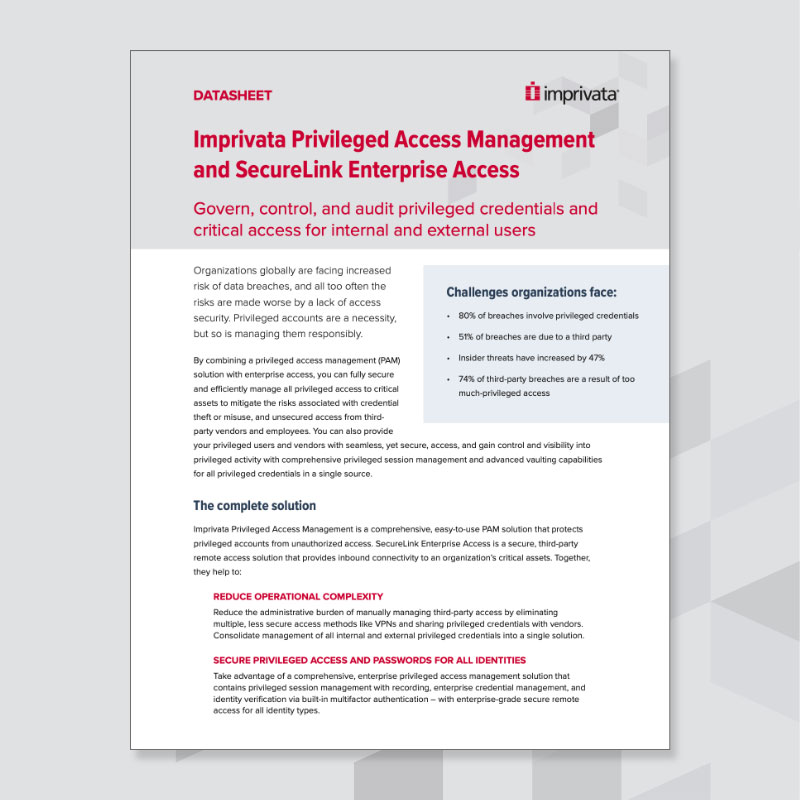PAM and VPAM: The power couple safeguarding critical assets from inside and outside threats
Threats exist internally and externally, so you need to make sure you’re prepared. The powerful combo of PAM and VPAM can help keep your organization safe.
When it comes to cybersecurity, anything less than a holistic strategy is essentially asking for trouble. Ensuring a 360° approach means maintaining a sharp, vigilant focus on both internal and external risks.
While that’s the overall purpose of data security, it’s especially vital – and can sometimes be underestimated – when it comes to locking down an organization’s most sensitive information. The powerful combination of privileged access management (PAM) and vendor privileged access management (VPAM) addresses this challenge, helping to ensure protection of critical assets on both fronts.
Growing risks and high stakes
While the statistics may not be surprising to some, they remain daunting. The impact of cyberattacks continues to paint a costly, troubling picture:
- Average data breach costs rose from $3.86 million in 2020 to $4.24 million in 2021
- 80% of security breaches involve privileged access abuse
- 74% of third-party breaches are a result of too much privileged access
- 51% of organizations suffered a data breach over the past year due to poor third-party security
Why are privileged accounts such an attractive target? For starters, they’re where cybercriminals can typically do the most damage. By breaching accounts that hold the most confidential, sensitive information, bad actors can significantly disrupt or damage organizational operations. In addition, ineffective password management policies and poor user behaviors make these attractive targets vulnerable to misuse, threats, and attacks.
A powerful tandem team
PAM and VPAM create layered protection, securing critical data by controlling, monitoring, and securing privileged accounts with elevated permissions. PAM does this in conjunction with internal user access, while VPAM secures vendor- and third-party access.
Working in tandem, PAM and VPAM provide valuable benefits that support digital identity strategies, enabling organizations to:
- Reduce operational complexity by eliminating multiple, less secure access methods
- Secure privileged access and passwords for all identities
- Gain total visibility into account activity and demonstrate compliance through detailed reporting
- Take back control through granular access to specific applications, based on Zero Trust
- Help ensure eligibility and favorable rates for cybersecurity insurance
A quick look under the hood
The power of PAM and VPAM solutions is driven by a multi-pronged approach to securing privileged accounts, while providing seamless access for authorized users. Key components include functionality such as:
- A password vault to secure credentials
- A job engine to rotate passwords and discover privileged accounts
- A sessions manager to monitor account access and behaviors
- Access controls enabling automated, granular provisioning/deprovisioning
Why zero counts for a lot
The importance of Zero Trust was noted above, and with good reason. Along with identity governance, single sign-on and multifactor authentication, PAM and VPAM are foundational to an organization’s ability to establish a Zero Trust posture.
Based on the tenet “never trust, always verify,” Zero Trust views trust as a vulnerability when it comes to digital security. It’s centered in strict, continuous identity verification through a sharp focus on authentication and authorization for each user, device, application, and transaction. And it’s quickly gaining momentum: more and more organizations are adopting a Zero Trust approach, and the U.S. government has incorporated it into its digital security architecture for all federal agencies.
An important component of Zero Trust is the “least privilege” principle. Following this principle helps organizations to minimize risk by allowing both internal and external users only the level of access they need to perform a task – and no more. Least privilege is also marked by a just-in-time approach, in which users are allowed access long enough to complete a task, after which access is disallowed.
Why this couple should be inseparable
The bottom line is that the best intentions are not good enough. Failing to step back and take a holistic approach to protection opens the door to significant potential for risk. Similarly, a PAM solution without a complementary VPAM solution can leave organizations exposed to a host of external vulnerabilities.
The average organization has hundreds of third-party vendors with access to critical data as they work to support various network systems and applications. And of course, that leaves organizations only as secure as the weakest third-party links, which may have poor security practices or malicious intentions. That in turn presents a potentially high-stakes risk for misused or stolen credentials. And because they’re outside entities, their access activities can be a lot harder to track and manage in comparison to internal users. VPAM helps organizations to mitigate this risk by controlling and monitoring third-party access to critical data.
Together, PAM and VPAM provide powerful solutions to help secure privileged account access and passwords for all identities, while ensuring seamless access for authorized users – inside and out.
A single-source solution
Imprivata has a complete solution to cover all your sensitive data protection needs. With our recent acquisition of another digital identity leader, SecureLink, we can bring you proven PAM and VPAM solutions – all with the convenience of one vendor.
To learn more, check out the datasheet highlighting benefits of our comprehensive internal and external solutions for privileged access management.

